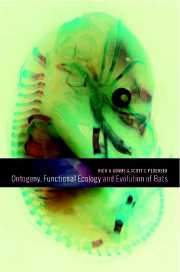Book contents
- Frontmatter
- Contents
- List of contributors
- 1 Integrating ontogeny into ecological and evolutionary investigations
- 2 Bat phylogeny: an evolutionary context for comparative studies
- 3 Early embryology, fetal membranes, and placentation
- 4 Brain ontogeny and ecomorphology in bats
- 5 Evolutionary plasticity and ontogeny of the bat cochlea
- 6 Skull growth and the acoustical axis of the head in bats
- 7 Ontogeny of the chiropteran basicranium, with reference to the Indian false vampire bat, Megaderma lyra
- 8 A theoretical consideration of dental morphology, ontogeny, and evolution in bats
- 9 Wing ontogeny, shifting niche dimensions, and adaptive landscapes
- 10 Ontogeny and evolution of the hindlimb and calcar: assessing phylogenetic trends
- 11 A comparative perspective on the ontogeny of flight muscles in bats
- 12 The ontogeny of behavior in bats: a functional perspective
- Index
1 - Integrating ontogeny into ecological and evolutionary investigations
Published online by Cambridge University Press: 17 August 2009
- Frontmatter
- Contents
- List of contributors
- 1 Integrating ontogeny into ecological and evolutionary investigations
- 2 Bat phylogeny: an evolutionary context for comparative studies
- 3 Early embryology, fetal membranes, and placentation
- 4 Brain ontogeny and ecomorphology in bats
- 5 Evolutionary plasticity and ontogeny of the bat cochlea
- 6 Skull growth and the acoustical axis of the head in bats
- 7 Ontogeny of the chiropteran basicranium, with reference to the Indian false vampire bat, Megaderma lyra
- 8 A theoretical consideration of dental morphology, ontogeny, and evolution in bats
- 9 Wing ontogeny, shifting niche dimensions, and adaptive landscapes
- 10 Ontogeny and evolution of the hindlimb and calcar: assessing phylogenetic trends
- 11 A comparative perspective on the ontogeny of flight muscles in bats
- 12 The ontogeny of behavior in bats: a functional perspective
- Index
Summary
As far as morphological change is concerned, evolution acts by altering development.
Liem & Wake (1985)Given that resource utilization abilities and predation risk are generally related to body size, many species will undergo extensive ontogenetic shifts in food and habitat use. Such shifts create a complex fabric of ecological interactions in natural communities.
Werner & Gilliam (1984)The field of ‘integrative biology’ utilizes multidisciplinary approaches to establish a more complete and, therefore, insightful interpretation of an organism's biology. Certainly there is nothing unprecedented about integrative strategies in seeking to understand the natural world. In fact, the major structuring of Western science 2500 years ago by Aristotle and others involved those simultaneously interested in a wide range of topics from gross anatomy, physiology, chemistry, classification of organisms, astronomy, philosophy, and earth sciences. Even as late as the 18th and 19th centuries, integrative biology was alive and well and most investigators saw little need for establishing hard boundaries between subdisciplines. For example, Darwin was a master of integrative biology who, in forming his dynamic view of life, embraced studies in embryology, paleontology, functional morphology, animal husbandry, heredity, biogeography, ecology, earth sciences, and even physics. The 20th century witnessed the establishment of strong subdisciplinary boundaries that effectively compartmentalized biology into numerous factions whose investigators rarely collaborated. Despite this divisive trend, some biologists continued to seek interdisciplinary connections. The ‘Grand Synthesis’ was ushered in by Fisher (1930) and others who sought to bridge the artificial schism between genetics and evolutionary theory. Evolution and genetics were united into the field of population genetics which allowed unprecedented insights into microevolutionary change.
- Type
- Chapter
- Information
- Publisher: Cambridge University PressPrint publication year: 2000



